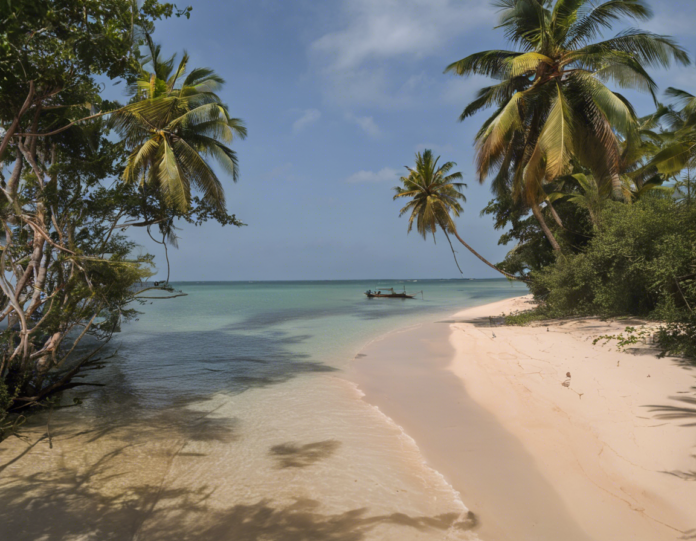Off the shores of Sri Lanka lies a hidden gem that holds both historical significance and natural beauty – Katchatheevu Island. Situated in the Palk Strait between the Indian state of Tamil Nadu and the northern region of Sri Lanka, this small yet captivating island has captivated the curious minds of adventurers, historians, and nature enthusiasts alike. In this article, we will delve into the secrets of Katchatheevu Island, uncovering its history, its significance, and the wonders it has to offer to those who dare to explore its shores.
History of Katchatheevu Island
Katchatheevu Island has a storied past that dates back centuries. The island has been a bone of contention between India and Sri Lanka due to its strategic location in the Palk Strait. In 1974, an agreement was signed between the two nations, handing over the island to Sri Lanka. This decision was met with mixed reactions, sparking debates and protests among the local fishermen communities who relied on the island’s waters for their livelihood. Despite these controversies, Katchatheevu Island remains a symbol of the complex historical ties between India and Sri Lanka.
Geographical Features
Katchatheevu Island spans an area of approximately 280 acres and is known for its pristine white sandy beaches, crystal-clear waters, and diverse marine life. The island is a haven for snorkeling and diving enthusiasts, offering a glimpse into the vibrant underwater world of the Palk Strait. Its untouched natural beauty and tranquil atmosphere make it a perfect destination for those seeking a peaceful retreat away from the bustling mainland.
Cultural Significance
Beyond its natural allure, Katchatheevu Island holds immense cultural significance for the Tamil community in Sri Lanka. Annually, thousands of Tamil devotees from both India and Sri Lanka partake in the Katchatheevu church festival, a tradition that has been passed down through generations. The festival includes religious ceremonies, cultural performances, and rituals that pay homage to the history and heritage of the island. For many, Katchatheevu Island is not just a place of scenic beauty but a sacred site deeply intertwined with their cultural identity.
Biodiversity and Conservation Efforts
The waters surrounding Katchatheevu Island teem with a diverse array of marine life, including colorful coral reefs, tropical fish, sea turtles, and even rare species of dolphins and whales. Conservation efforts have been put in place to protect these ecosystems and ensure their sustainability for future generations. Organizations and local authorities have taken steps to regulate fishing activities, promote responsible tourism, and raise awareness about the importance of preserving the island’s natural habitats.
Tourism and Accessibility
While Katchatheevu Island remains relatively untouched by mass tourism, its allure has attracted a niche group of travelers seeking off-the-beaten-path experiences. Access to the island is restricted, and visitors are required to obtain prior permission from the Sri Lankan authorities to visit. Day trips and excursions are offered by local tour operators, allowing visitors to explore the island’s beauty and immerse themselves in its tranquil surroundings. For those seeking a unique adventure amidst unspoiled nature, Katchatheevu Island presents a compelling destination worth discovering.
Frequently Asked Questions (FAQs)
Q: Is it possible to visit Katchatheevu Island as a tourist?
A: Yes, it is possible to visit Katchatheevu Island as a tourist, but visitors are required to obtain permission from the Sri Lankan authorities before embarking on their journey.
Q: What is the best time of year to visit Katchatheevu Island?
A: The best time to visit Katchatheevu Island is during the dry season, which typically runs from December to March, when the weather is pleasant and conducive for outdoor activities.
Q: Are there accommodation options available on Katchatheevu Island?
A: There are no accommodation options on Katchatheevu Island itself. Visitors usually opt to stay in nearby towns or villages and take day trips to the island.
Q: What are some activities to do on Katchatheevu Island?
A: Popular activities on Katchatheevu Island include snorkeling, diving, beachcombing, birdwatching, and attending cultural events such as the Katchatheevu church festival.
Q: What are the rules and regulations for visiting Katchatheevu Island?
A: Visitors must abide by the rules and regulations set by the Sri Lankan authorities, which may include restrictions on fishing, waste disposal, and respecting the cultural heritage of the island.
Q: Can I go fishing around Katchatheevu Island?
A: Fishing around Katchatheevu Island is regulated, and visitors are advised to seek guidance from local authorities on permissible fishing practices and protected areas.
Q: Is Katchatheevu Island accessible by boat from India?
A: While Katchatheevu Island is geographically closer to India, access to the island is restricted, and visitors are required to depart from Sri Lanka with the necessary permits.
Q: What should I pack for a day trip to Katchatheevu Island?
A: Essential items to pack for a day trip to Katchatheevu Island include sunscreen, snorkeling gear, water, snacks, appropriate clothing, and respect for the local customs and environment.
Q: Are there guided tours available for exploring Katchatheevu Island?
A: Yes, local tour operators offer guided tours and day trips to Katchatheevu Island, providing visitors with insights into the island’s history, culture, and natural heritage.
Q: Is camping allowed on Katchatheevu Island?
A: Camping on Katchatheevu Island is generally not permitted due to conservation efforts and restrictions on overnight stays. Visitors are advised to plan day trips to the island instead.
As you embark on your journey to uncover the wonders of Katchatheevu Island, remember to respect its historical, cultural, and environmental significance. From its turquoise waters teeming with life to its golden shores steeped in tradition, this hidden gem in the Palk Strait invites you to immerse yourself in a world of beauty and tranquility unlike any other.










